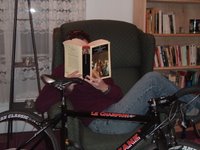I've begun reading The Mezzanine, by Nicholson Baker, and guess what? It's a novel with footnotes! Not the usual kind of scholarly footnotes written by an editor, but footnotes written by the first-person narrator. I had no idea! I've only read about 15 pages of the novel -- which is short at 135 pages -- so I can't say much about whether they work or not, but so far, I'm liking it. In typical Nicholson Baker-fashion, the book gives you everything in minute detail: the setting, the character's thoughts, the action -- which, as I understand it, consists of the main character taking an elevator ride. The footnotes elaborate in great detail on the already detailed main text, explaining such things as the history of staplers, the history of straws, and how the narrator pulls up his socks. This could be intensely annoying, but so far it's not, although I am predisposed to like this book, as I like other things Baker's written (especially U & I). I love novels with gimmicks. The list of great ones -- Tristram Shandy ... Pale Fire ... Ulysses, the ultimate gimmick novel. The Mezzanine is a definite contribution, a very funny book about the human mind. Mesmerizing.
Thanks to Barry for pointing out Mark Dunn's novel Ibid, a novel made up entirely of footnotes. This, clearly, I will have to check out.
One of the blurbs for The Mezzanine says this:
I don't like this reviewer calling these novels gimmicky. Isn't the term "gimmicky" kind of dismissive? These novels are more than just gimmicks; they are experiments, explorations, novels where the author is pushing the limits of what a novel can do. If something is gimmicky, it's interesting only in its newness and tricksiness, but these books do new things and also old things -- old things like telling us what it's like to be a person or to live in one's mind or to experience the world or to be obsessed with another person.
Anyway, here's an excerpt from one of Baker's footnotes, one that's about reading and eating:
I stared in disbelief the first time a straw rose up from my can of soda and hung out over the table, barely arrested by burrs in the underside of the metal opening. I was holding a slice of pizza in one hand, folded in a three-finger grip so that it wouldn't flop and pour cheese-grease on the paper plate, and a paperback in a similar grip in the other hand -- what was I supposed to do? The whole point of straws, I had thought, was that you did not have to set down the slice of pizza to suck a dose of Coke while reading a paperback. I soon found, as many have, that there was a way to drink no-handed with these new floating straws: you had to bend low to the table and grasp the almost horizontal straw with your lips, steering it back down into the can every time you wanted a sip, while straining your eyes to keep them trained on the line of the page you were reading. How could the staw engineers have made so elementary a mistake, designing a straw that weighed less than the sugar-water in which it was intended to stand? Madness!



|